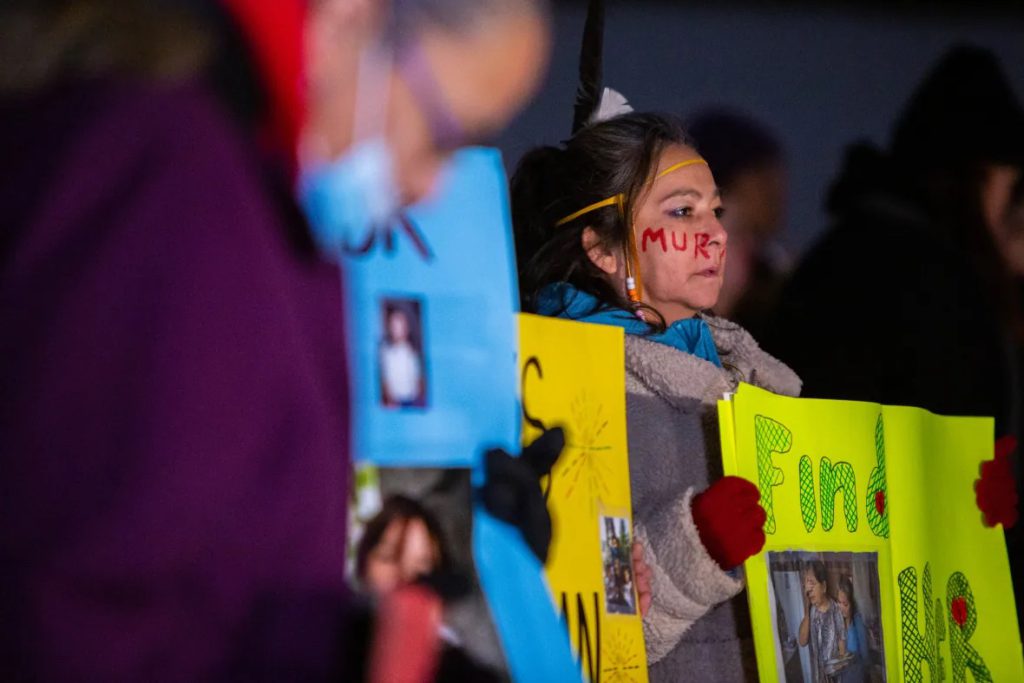By Meaghan Churchill, Tatiana Gordon, and Caroline Jones
Content Warning: This case may be distressing and awaken memories of past traumatic experiences and abuse.
The National Indian Residential School Crisis Line provides 24-hour crisis support to former Indian Residential School students and their families toll-free at 1-866-925-4419.
Individuals impacted by the issue of Missing and Murdered Indigenous Women and Girls are encouraged to contact the MMIWG Crisis Line toll-free at 1-844-413-6649.
First Nations, Inuit and Métis seeking immediate emotional support can contact the Hope for Wellness Help Line toll-free at 1-855-242-3310, or by online chat at hopeforwellness.ca.

In early December of 2022, the Winnipeg police services announced that four charges of first-degree murder had been laid against alleged serial killer Jeremy Skibicki. The community was shocked to hear of the murders of Morgan Harris, 39, Marcedes Myran, 26, Rebecca Contois, 24, and a fourth unidentified woman the community has named Mashkode Bizhiki’ikwe, or Buffalo Woman.
The utter shock quickly turned to anger as further details of the crimes circulated through local and national news, and the community was made aware of the timeline of events. Winnipeg police reported that alleged serial killer Skibicki had been on police radar since 2015, due to an assault that year on his pregnant common-law partner where, according to a statement of facts later agreed to by Crown and defence attorneys, “Skibicki grabbed his partner’s hair and punched her in the face several times, then tried to strangle her. He also told her he would kill her if she called police.”1
Skibicki’s violent crimes against women continued between 2015 and 2022, all while several judges granted protection orders to different women against him. During this time, Skibicki spent two months behind bars for the 2015 assault and two years on probation.
In May 2022, police informed the public about the murder of 24-year-old Rebecca Contois after finding her partial remains between two separate locations, an apartment building and Brady Landfill, a local waste disposal site. At this time, Skibicki was charged with the original first-degree murder in connection with Contois’ death.2 At the time of investigation, police did not rule out the possibility of other victims.
Almost half a year later, police disclosed to the media and public the three additional charges of first-degree murder against Skibicki, for the deaths of Morgan Harris, Marcedes Myran and a third unidentified victim. All four of the victims who are alleged to have been killed by Skibicki are Indigenous women who were located in Winnipeg at the time of their disappearances.
While grappling with the deaths of these women, their families and community members were met with further heartbreak as the police informed the public that their remains were located in the Prairie Green landfill site and that they had no plans to search the scene to locate the deceased women.3
Police originally cited the decision not to search the location, saying the task exceeded their capabilities as a police force.4 After receiving harsh criticism from the families of the deceased and public outcry, the police seemingly reworded their decision not to search the site, citing safety concerns.
After weeks of developments, public outcry and the news media following closely, the Canadian federal government said they will fund a feasibility study of the landfill site. The news of this funding came shortly after Prime Minister Trudeau stated in the house of commons, “We have received the letters from the families. We see the level of pain and the federal government will look to do whatever we can to support the province, the city and whoever needs support in terms of giving closure and justice for these families.”5
While the families and communities are relieved to hear of these updates in the landfill search and the possibility of finally having proper closure, it is unfortunate that it took the families pleading with police and government officials to even think about other ways of locating these women’s bodies.
While ethically, some may detest the continued media coverage of crime, citing consideration for the victims, families, and the accused. While those are valid ethical considerations, it is important to operate case by case to avoid generalizations. In this example, the families and communities are asking the public for help, trying to gain the attention of the Winnepeg police department to do a search of the landfill to locate the bodies of the murdered women. Looking at the media coverage of this case, it is clear that keeping the story alive has helped to invoke change and get the attention of the federal government to fund a feasibility study.

In Murder in Our Midst, Fullerton and Patterson discuss the coverage of crime internationally and the different coverage models of journalists in different countries. The authors acknowledge that crime reporting has become a form of entertainment for some, explaining, “crime stories rivet public attention and create social buzz. As a genre, they continue to enjoy tremendous popularity across time, countries, and increasingly fragmented populations.”6
The two then explain that in their research, Canadian crime coverage typically falls into the watchdog model, “where journalists firmly believe in an ethical obligation to inform the public and keep a watchful eye on police and the criminal justice system. Their stories often outline as many details as legally possible about anyone arrested or convicted under newsworthy circumstances. Harm to defendants’ reputations and possible shaming of their families through publicity is seen sometimes as regrettable collateral damage. The push is to publish.”7
This case showcases the relationship between crime and media and depicts how journalists can utilize their platforms to increase awareness and help bring about change. While scholars have acknowledged that often the public’s interest in true crime stories may come as a form of entertainment and become detached from the real-world impact. Journalists are able to sway the narrative and ensure that the public is consuming accurate and informative material, not just flashy headlines meant to lure the reader in.
The murders of these four women also bring about attention to the troubling reality of Missing and Murdered Indigenous Women and Girls (MMIWG) in Canada and the United States. Often in cases of missing and murdered Indigenous women, their families and community have to work tirelessly to gain the proper police attention these cases deserve, and this case shows to be no different.
The claims from Winnipeg police, that searching the landfill may be “impossible” seems to be a jump to judgment, especially when considering similar cases have ended in the search and recovery of murder victims from landfills in Canada. For example, Toronto police spent months in 2021 searching Green Lane Landfill near London, Ont. for the remains of a missing man, where they had information that his body may be located there. Subsequently, the man’s deceased body was located in the landfill during the search, which was described as “the largest of its kind in the history of Toronto, involving hundreds of officers and multiple units, with some officers putting in volunteer hours”8.
When looking at the case of the murdered Indigenous women of Winnipeg, consistent and accurate journalist coverage may be the key to holding the government and police accountable, ensuring that the murdered women and their families receive the proper closer and justice. While there is a fine line between entertainment and ethical consumption of true crime media, it is clear that the watchdog model that is prominent in Canadian media and has the ability to increase awareness and invoke positive change.
Discussion Questions
- Should the media only follow cases in-depth when the families are involved with the media coverage?
- Should alleged killers be named in news articles? Or should reporters avoid doing so in an attempt to not give the alleged notoriety?
- Looking at this specific case of the four murdered women in Winnipeg, do you think earlier coverage of the crimes against women at the hands of the alleged could help to prevent his further crimes and murders?
Endnotes
[1] (Gowriluk 2022).
[2] (Lefebvre 2022).
[3] (Maclean 2022).
[4] (Maclean 2022).
[5] (Bergen 2022).
[6]] (Fullerton and Patterson 2020, 1).
[7] (Fullerton and Patterson 2020, 10).
[8] (Woodward 2021).
Bibliography
Bergen, Rachel. 2022. “Feds will fund feasibility study of landfill search for remains of 2 women: AMC.” CBC. https://www.cbc.ca/news/canada/manitoba/winnipeg-landfill-search-trudeau-winnipeg-police-1.6685984.
Fullerton, Romayne S., and Maggie J. Patterson. 2020. Murder in Our Midst: Comparing Crime Coverage Ethics in an Age of Globalized News. N.p.: Oxford University Press.
Gowriluk, Caitlyn. 2022. “A timeline of what we know about 4 slain Winnipeg women and alleged serial killer Jeremy Skibicki.” CBC. https://www.cbc.ca/news/canada/manitoba/jeremy-skibicki-winnipeg-alleged-serial-killer-timeline-1.6681433.
Lefebvre, Charles. 2022. “Jeremy Skibicki: More victims identified in Winnipeg homicide investigation | CTV News.” CTV News Winnipeg. https://winnipeg.ctvnews.ca/alleged-serial-killer-in-winnipeg-accused-of-killing-3-more-women-1.6177003.
MacLean, Cameron. 2022. “Finding remains of Winnipeg homicide victims in landfill may be ‘impossible’: forensics expert.” CBC. https://www.cbc.ca/news/canada/manitoba/landfill-search-homicide-victims-jeremy-skibicki-1.6681314.
Woodward, Jon. 2021. “Toronto police make ‘needle-in-a-haystack’ discovery, find missing man’s remains in landfill.” CTV News Toronto. https://toronto.ctvnews.ca/toronto-police-make-needle-in-a-haystack-discovery-find-missing-man-s-remains-in-landfill-1.5571419.
